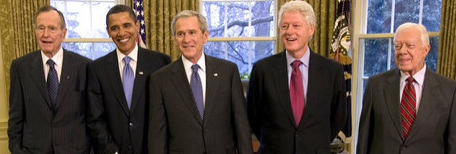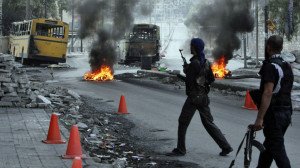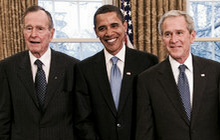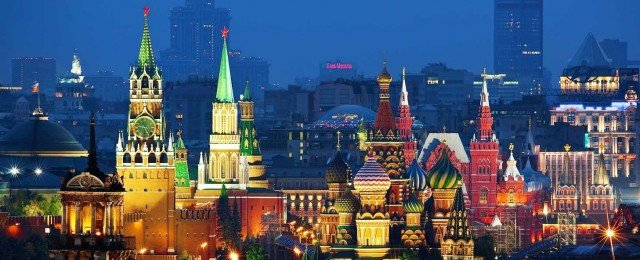
Syrian Conflict: Proxy War against the proxies
… by Seth Ferris, … with New Eastern Outlook, Moscow
– First published May 1, 2014 –

According to Dr. Vakhtang Maisaia, a regional specialist in international relations, “the ongoing Syrian civil war has already evolved into a conflict between civilizations and reshaped into a local war.” However it is a war in which both of the indigenous combatants are fighting for the same thing.
Both the united opposition and the government forces loyal to President Assad are rediscovering their Pan-Arabism by fighting each other. They share a common disenchantment with the US Administration and President Obama, rooted in the widespread belief that US policies have not changed very much from the Bush years, despite the improved rhetoric.
Both sides, even the rebels supported by the US, are growing increasingly resentful at the fact that the war would have ended long ago, one way or another, if the US and its proxies had not prolonged it for their own financial and strategic purposes under the guise of supporting the rebels.
There is a reason the various uprisings in the Middle East and North Africa have become known as the Arab Springs. There are plenty of other ethnic groups in the countries where they have occurred and longstanding social and confessional conflicts between the Arab communities within them.
But the protestors in each country have delivered one fundamental message: “We are Arabs, not infidels, so expect to be treated better by you traitors”. The governments in each of these countries have also responded with a common message: “We are Arabs too, and therefore your representatives, you cannot attack us because it is attacking yourselves.”
Pursuing both lines of argument simultaneously has simply strengthened and confirmed the Arab identity. What Nasser was unable to achieve in the days of the United Arab Republic of 1958 to 1961 – a merger of Egypt and Syria – is fast coming to pass.
The various Arab Springs are redefining the model of what an Arab state should be. By doing so, they are creating increasing resentment at the hijacking of this process by external powers – who are now fighting ever harder to maintain control of the situation by insisting the conflicts must be about what they want them to be about, and fought on their terms.
Back in December 2010 – yes, it was that long ago – a young street merchant, Mohamed Bouazizi, set himself on fire in protest at the endemic corruption in his native Tunisia.
This corruption had never been part of international political discourse – though a domestic issue, you would be hard pressed to find any international symposium which has fully discussed it. Nevertheless, the great powers chose to get involved in an issue they clearly cared little about to fight their own battles.
The US and its allies supported the uprising in the name of “democracy”, coincidentally finding new markets for the arms dealers with a track record of funding US Congressmen, Senator John McCain being the most notorious example. As ever, the US had done little to actually introduce democracy to Tunisia previously, not considering it to be in the US interest.
Obviously Russia and its Eastern allies, sponsors of many Arab World governments, then defended their own interests, on the principle that “two can play at that game”. Consequently the conflict soon became what the US-dominated world media termed “democracy” versus “dictatorship”, allegedly represented by the Eastern powers.
However those same media, and their sponsors, subsequently failed to explain why Tunisia then ended up with a largely Islamist government when such regimes are routinely derided in the West as anything but democratic. If that was the solution, was the problem what we were told it was?
We then saw what happened in Egypt, where the Muslim Brotherhood was touted as the “only opposition group worth mentioning” until it actually achieved its goals and the West did not want us to see what these were – even though they had been freely chosen by Egyptian voters from amongst the choices they were allowed to have.
We have seen the Yemeni government overthrown by an opposition coalition supported by al-Qaeda and the Believing Youth; both were considered terrorist organisations by the rest of the time, at least when they are not furthering US interests.
In these and all the other Arab Spring countries the local conflicts have been presented as “Western freedom” versus “Eastern-backed corruption”. But in each case, local combatants have devised very un-Western solutions to the real problems they were fighting over. These solutions have disappointed the West because they have been redefinitions of what an Arab state should be, not a clearly pro-Western or pro-Eastern solution.
Continued external interference has then pitted Arab solutions against Western ones – as we have seen in Egypt, where a civil dictatorship was replaced in elections by a religious dictatorship, exactly what “democracy” is supposed to prevent, in Western thinking. .
The Suez Crisis of 1956 is not ancient history in the Arab world. It remains a defining moment of Arab consciousness, whether or not the leaders involved are now approved of. The sheer scale of the external involvement in the Arab Springs has practically guaranteed that Pan-Arabism of the 1950s model is reemerging as the basic Arab political principle – and now, with the decline in real US power proportionate to the rise of Russia and China, it perhaps has more chance of ultimate success.
______________________
Case of Syria

As Dr. Maisaia has pointed out, the Syrian conflict can be regarded as part of a single local war in the Middle East.
The Arab Spring in Egypt, the escalation of military activities by Palestine and Israel in Gaza, the direct involvement in the Syrian conflict of four thousand members of the Iranian “Islamic Revolutionary Guard”, the involvement of Iran’s ally, the ruling Hezbollah movement in Lebanon, and the Hamas rulers of Gaza, on the Bashir Assad regime’s side and the direct participation in Syria of more than 60,000 foreign mercenaries, including some from the Caucasus, are not random occurrences.
They are linked by two things – the ongoing proxy war between the great powers and the fact that Arab countries are where the fighting is taking place.
Just because something happens in one Arab country does not mean that the same must happen in another, unless you adhere to the crudest racial stereotypes. But Arabs everywhere are now seeing a threat to their identity in ongoing Western involvement in the region. Hence the various combatant sides are not trying to claim allegiance to one external power or another but presenting themselves as “More Arab Than Thou” to try and win hearts and minds.
Though both sides still seek external assistance and validation, they have willfully put themselves in a position where victory equals diminished foreign influence. This is exactly why conflict, rather than solution, is the Western policy in each of the affected countries.
______________________
“Keeping it Simple”

But the US saw all this coming. The George W. Bush Administration developed a distinct policy on the Arab Middle East: it labelled certain countries as “moderates” (Saudi Arabia, Egypt, and Jordan) and others as “radicals” (Iran and Syria) despite the fact their systems of government and patterns of alliances cut right across this demarcation line. Everything was perceived as black and white, with the US of course being the whitest of all.
This policy hasn’t worked because Arabism is now again more important than ideological positioning vis-à-vis the West. Governments and peoples are more interested in being Arab than moderate or radical: eventually, all combatant sides have taken the same positions concerning the foreign sponsors they initially coveted to support their version of Arabism.
The most common complaint of protestors in every Arab country, which underpins their basic message, is not that their government is behaving badly on its own initiative but that its behavior is a product of external influence. In both Egypt and Saudi Arabia the governments were believed to be implementing US policy at the expense of the people, the implication being that if they were real Arabs they would be more independent.
Whether labelled moderate or radical, they were expected to be “Arab” – the point at issue was not what foreign sponsor an Arab preferred, but what the word “Arab” actually meant in practice.
______________________
Why it won’t end anytime soon
To begin with, the civil strife or “Syrian Arab Spring” developed in a similar manner to the Egyptian version. The protestors likewise demanded regime change and the resolution of increasing social problems. Gradually it reshaped into an ethnic-confessional confrontation between the Shia-Alawite minority and the Sunni-Arab majority – reflecting a divide about which of these groups is the “true representative of Islam” – and thus truly Arab, despite the large numbers of Arab Christians – going back many centuries.
The US doesn’t want this conflict to be about that. If it is about “democracy”, the US will continue to seek to impose its own models or blame all Syria’s future problems on lack of democracy. Either way, it can retain its own allies and influence.
But in a state with Pan-Arabism as its highest value, the US would be increasingly irrelevant. So the longer it can keep the conflict going, in the hope of changing what it is about by force, the better.
There is another reason the US doesn’t want the Arab Springs to end. According to the US, democracy has already won in the countries where the regime has changed. But as Robert D. Kaplan, a senior fellow at the Center for a New American Security, pointed out:
“American diplomacy in the Arab world is about to become even more intricate. No longer will it be a matter of having one telephone number to call in each country. Henceforth, Washington will have to deal with dozens of political personalities to get the same things done as it used to with just one leader. Democracy equals complexity.”
Just imagine what will happen if those dozens of political personalities agree with each other more than they agree with the US. But that is exactly what they are doing, over an increasingly large chunk of the map, having rediscovered a higher common value by being encouraged to fight over it.
Seth Ferris, investigative journalist and political scientist, expert on Middle Eastern affairs, exclusively for the online magazine “New Eastern Outlook.”
Editing: Jim W. Dean and Erica P. Wissinger
_______________________

Jim W. Dean was an active editor on VT from 2010-2022. He was involved in operations, development, and writing, plus an active schedule of TV and radio interviews.
ATTENTION READERS
We See The World From All Sides and Want YOU To Be Fully InformedIn fact, intentional disinformation is a disgraceful scourge in media today. So to assuage any possible errant incorrect information posted herein, we strongly encourage you to seek corroboration from other non-VT sources before forming an educated opinion.
About VT - Policies & Disclosures - Comment Policy




